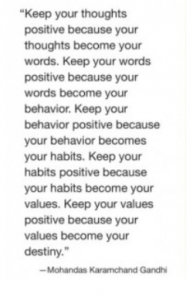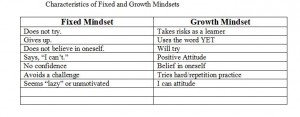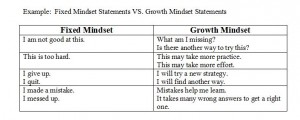As the year progresses and things get tough–self confidence and self-esteem becomes a stronger predictor of success. So many of our students begin to buckle as the work becomes more difficult. Teachers can scaffold to make learning more attainable but there is still time that students MUST persevere through difficult tasks.
I was inspired to revisit some research that I completed about self confidence and how it affects learning.
Self-esteem or confidence actually resides in the frontostriatal section of the brain which is located between the ventral striatum and the prefrontal cortex (Decision making, personality and social parts of brain) according to Anna Almendrala (2014). The ventral striatum is associated with feelings of motivation and reward. Studies have shown that with continual positive or negative statements and emotions an increase or decrease can occur in the activity of this pathway of the brain. Therefore this affects the person’s self-esteem.
According to Susana Martinez-Conde from Barrow Neurological Institute in Phoenix, our brain “makes use of two types of knowledge everyday: explicit knowledge (the “know what” type) and implicit knowledge (the “know how”). She uses the example of explicit knowledge is knowing your math facts which is something concrete but implicit knowledge is riding a bike which is something you know how to do. Implicit knowledge is not as easy to explain to someone because it uses many functions and actions to complete the action—you know how to do it.
Self-confidence is an element added to these two types of knowledge which affects our ability to share or retrieve this knowledge based on what she calls real memories or fake (subconscious). Our subconscious (fake memories) actually is the foundation for how our own confidence is ascertained. Our subconscious is much like a “recorder” because it is taking information from all of our senses and recording impressions. Our subconscious is different from other information taken in from our brain which is manipulated, organized and utilized in a purposeful way. The information from our subconscious is simply brought in and impressions recorded. When we are engaged in certain activities, these impressions will cause anxiety or enjoyment or lack of confidence based on previous information gathered by our subconscious.
Powerful Information!! Think about a student from a home where literacy is not celebrated. This could be for various reasons; parents uncomfortable reading, lack or unstructured time, unstable environment. The events are not necessarily remembered but an overall impression is being created in the brain as the subconscious records the events. These recordings are creating negative feelings that will be associated with literacy. In contrast, our children who grow up in literacy rich homes feel comfortable with reading and more willing to try because the subconscious has recorded positive attributes with the event.
This immediately made me think of this quote from Ghandi.
The implications I have gathered through my research is that most likely our lowest performing students have developed a negative feeling or impression of the topic in which they struggle. When a negative thought is repeated many times it is actually being “recorded” and causes stress when the child engages in this activity. For example, speaking publicly is very difficult for me because I lack confidence in that area and I have over the years developed negative feelings about being in that situation. To combat this low self-confidence or negative feeling in our students, we must replace the negative connotation with positive repeatedly.
Positive affirmation can simply be a smile! Smiling, positive feedback, encouraging words and simply being patient can help a child begin to “record” positive subconscious thoughts as they engage in the activity such as reading. The more positive and comfortable the student feels, the more likely they are to try harder and build higher self-confidence. For students who are extremely shut down, a tangible reward paired with positive feedback can begin to create the connection between the task and a good experience.
Positive feedback and sometimes a tangible trip to the prize box will activate the ventral striatum (home of reward and motivation) which connects to the frontostriatal (home of self-confidence). When these two sections of the brain work together, you are increasing both self-confidence and motivation which increases the engagement and openness to learn.
It is powerful to think that we can help change a person’s self-confidence and motivation. How often as teachers do we hear, “I can take a horse to water but I can’t make them drink.” I do not believe that old adage is true. With repetitive positive affirmation and helping a student feel success we can improve their motivation to try. This in turn will begin to build self-confidence. These factors together can increase the change of learning because the child becomes open to receive the information. We may not be able to “make them drink” but we can certainly motivate them to want to try!
For a related article, check out my April Blog entitled, “Too Much Stress= Impeded learning.” It explains how the brain reacts to stress and how it affects learning. In today’s blog it shared how confidence affects learning and how the subconscious can put learners in a state of stress. The April article focuses on how the brain reacts to high amounts of stress. In a state of continual stress, the brain will respond by short circuiting that pathway and stop impulses. This results in the lack of input and messaging in the brain which makes it short circuit that pathway and stops learning. In addition, a constant state of stress causes inability to stay on task, inattention, and lack of self control. (Poor behavior–sound familiar??)
https://thiskelly.edublogs.org/2016/04/15/too-much-stress-impeded-learning/
Articles that were cited and helped inspire this Blog:
Article by Anna Almendrala for Huffington Post: http://www.huffingtonpost.com/2014/06/16/self-esteem-brain_n_5500501.html accessed on July 20, 2016.
Article by Susana Martinez-Conde and Richard J. Haier on June 2008 entitled Ask the Brains: What are ideas? Does confidence Affect Performance. Accessed on July 22, 2016: http://www.scientificamerican.com/article/what-are-ideas/
Quote from values.com


